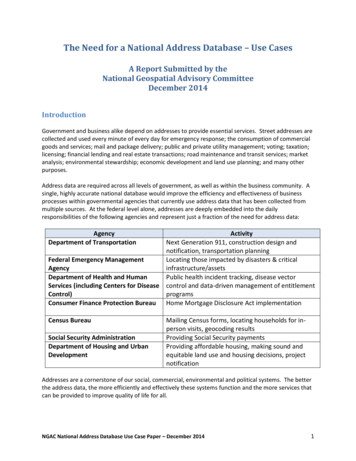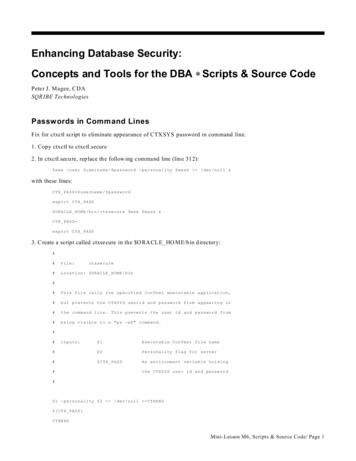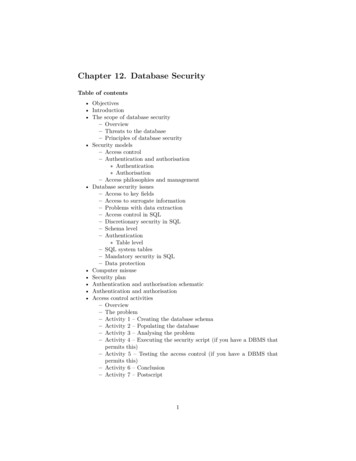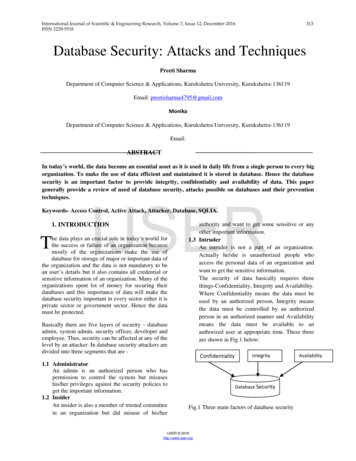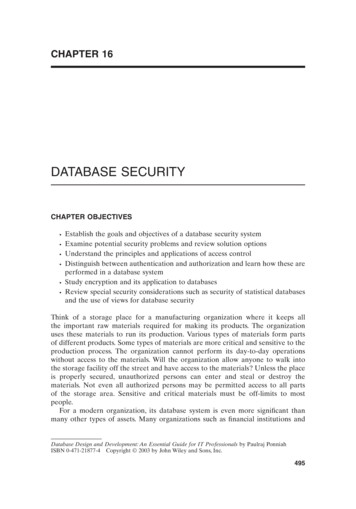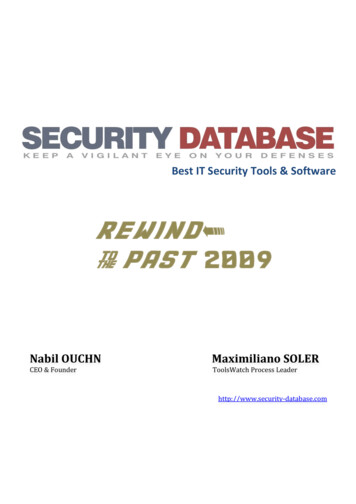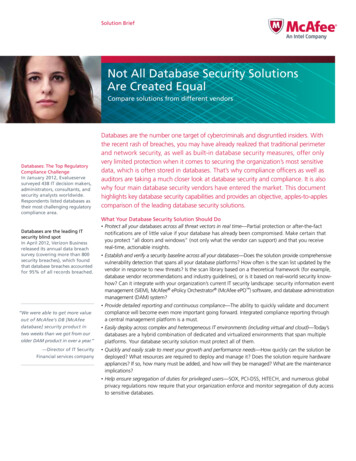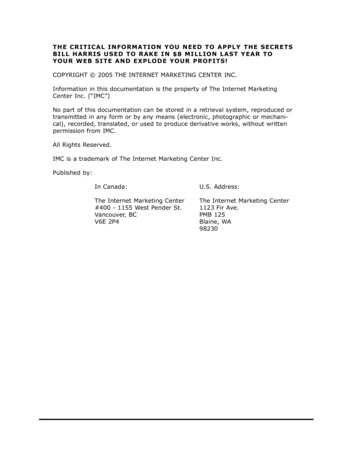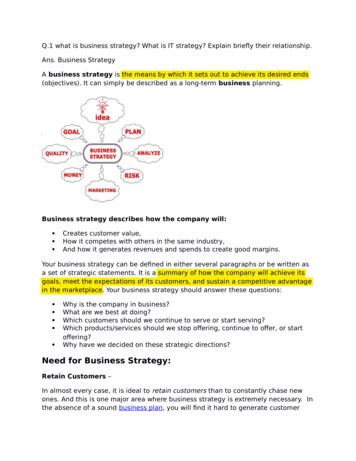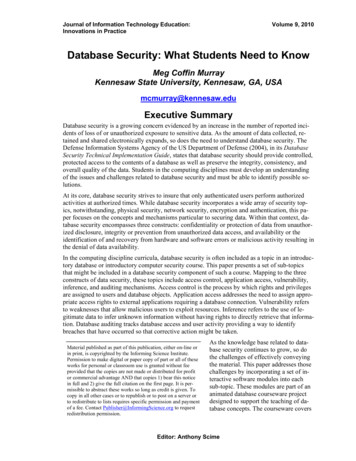
Transcription
Journal of Information Technology Education:Innovations in PracticeVolume 9, 2010Database Security: What Students Need to KnowMeg Coffin MurrayKennesaw State University, Kennesaw, GA, USAmcmurray@kennesaw.eduExecutive SummaryDatabase security is a growing concern evidenced by an increase in the number of reported incidents of loss of or unauthorized exposure to sensitive data. As the amount of data collected, retained and shared electronically expands, so does the need to understand database security. TheDefense Information Systems Agency of the US Department of Defense (2004), in its DatabaseSecurity Technical Implementation Guide, states that database security should provide controlled,protected access to the contents of a database as well as preserve the integrity, consistency, andoverall quality of the data. Students in the computing disciplines must develop an understandingof the issues and challenges related to database security and must be able to identify possible solutions.At its core, database security strives to insure that only authenticated users perform authorizedactivities at authorized times. While database security incorporates a wide array of security topics, notwithstanding, physical security, network security, encryption and authentication, this paper focuses on the concepts and mechanisms particular to securing data. Within that context, database security encompasses three constructs: confidentiality or protection of data from unauthorized disclosure, integrity or prevention from unauthorized data access, and availability or theidentification of and recovery from hardware and software errors or malicious activity resulting inthe denial of data availability.In the computing discipline curricula, database security is often included as a topic in an introductory database or introductory computer security course. This paper presents a set of sub-topicsthat might be included in a database security component of such a course. Mapping to the threeconstructs of data security, these topics include access control, application access, vulnerability,inference, and auditing mechanisms. Access control is the process by which rights and privilegesare assigned to users and database objects. Application access addresses the need to assign appropriate access rights to external applications requiring a database connection. Vulnerability refersto weaknesses that allow malicious users to exploit resources. Inference refers to the use of legitimate data to infer unknown information without having rights to directly retrieve that information. Database auditing tracks database access and user activity providing a way to identifybreaches that have occurred so that corrective action might be taken.Material published as part of this publication, either on-line orin print, is copyrighted by the Informing Science Institute.Permission to make digital or paper copy of part or all of theseworks for personal or classroom use is granted without feeprovided that the copies are not made or distributed for profitor commercial advantage AND that copies 1) bear this noticein full and 2) give the full citation on the first page. It is permissible to abstract these works so long as credit is given. Tocopy in all other cases or to republish or to post on a server orto redistribute to lists requires specific permission and paymentof a fee. Contact Publisher@InformingScience.org to requestredistribution permission.As the knowledge base related to database security continues to grow, so dothe challenges of effectively conveyingthe material. This paper addresses thosechallenges by incorporating a set of interactive software modules into eachsub-topic. These modules are part of ananimated database courseware projectdesigned to support the teaching of database concepts. The courseware coversEditor: Anthony Scime
Database Security: What Students Need to Knowthe domains of Database Design, Structured Query Language, Database Transactions, and Database Security. The Security Module, presented in this paper, allows students to explore such areasas access control, SQL injections, database inference, database auditing, and security matrices.The courseware was developed as part of a National Science Foundation grant and has been madefreely available at http://adbc.kennesaw.eduKeywords: database security, data integrity, database courseware, database vulnerability, accesscontrol.IntroductionDatabase technologies are a core component of many computing systems. They allow data to beretained and shared electronically and the amount of data contained in these systems continues togrow at an exponential rate. So does the need to insure the integrity of the data and secure thedata from unintended access. The Privacy Rights Clearing House (2010) reports that more than345 million customer records have been lost or stolen since 2005 when they began tracking databreach incidents, and the Ponemon Institute reports the average cost of a data breach has risen to 202 per customer record (Ponemon, 2009). In August 2009, criminal indictments were handeddown in the United States to three perpetrators accused of carrying out the single largest data security breach recorded to date. These hackers allegedly stole over 130 million credit and debitcard numbers by exploiting a well known database vulnerability, a SQL injection (Phifer, 2010).The Verizon Business Risk Team, who have been reporting data breach statistics since 2004, examined 90 breaches during the 2008 calendar year. They reported that more than 285 million records had been compromised, a number exceeding the combined total from all prior years ofstudy (Baker et al., 2009). Their findings provide insight into who commits these acts and howthey occur. Consistently, they have found that most data breaches originate from external sources,with 75% of the incidents coming from outside the organization as compared to 20% comingfrom inside. They also report that 91% of the compromised records were linked to organizedcriminal groups. Further, they cite that the majority of breaches result from hacking and malwareoften facilitated by errors committed by the victim, i.e., the database owner. Unauthorized accessand SQL injection were found to be the two most common forms of hacking, an interesting finding given that both of these exploits are well known and often preventable. Given the increasingnumber of beaches to database systems, there is a corresponding need to increase awareness ofhow to properly protect and monitor database systems.At its core, database security strives to insure that only authenticated users perform authorizedactivities at authorized times. It includes the system, processes, and procedures that protect a database from unintended activity. The Defense Information Systems Agency of the US Departmentof Defense (2004), in its Database Security Technical Implementation Guide, states that databasesecurity should provide “controlled, protected access to the contents of your database and, in theprocess, preserve the integrity, consistency, and overall quality of your data” (p. 9). The goal issimple, the path to achieving the goal, a bit more complex. Traditionally database security focused on user authentication and managing user privileges to database objects (Guimaraes, 2006).This has proven to be inadequate given the growing number of successful database hacking incidents and the increase in the number of organizations reporting loss of sensitive data. A morecomprehensive view of database security is needed, and it is becoming imperative for students inthe computing disciplines to develop an understanding of the issues and challenges related to database security and to identify possible solutions.Database security is often included as a topic in an introductory database course or introductorycomputer security course. However as the knowledge base related to database security continuesto grow, so do the challenges of effectively conveying the material. Further, many topics relatedto database security are complex and require students to engage in active learning to fully comIIP-62
Murrayprehend the fundamental nature of database security issues. This paper presents a set of subtopics for inclusion in a database security component of a course. These sub-topics are illustratedusing a set of interactive software modules.As part of a National Science Foundation Course, Curriculum and Laboratory ImprovementGrant (#0717707), a set of interactive software modules, referred to as Animated DatabaseCourseware (ADbC) has been developed to support the teaching of database concepts. Thecourseware has been made freely available and may be accessed at http://adbc.kennesaw.edu.ADbC consists of over 100 animations and tutorials categorized into four main modules (Database Design, Structured Query Language [SQL], Transactions and Security) and several submodules. Interactive instructional materials such as animations can often be incorporated into theinstructional process to enhance and enrich the standard presentation of important concepts. Animations have been found to increase student motivation, and visualizations have been found tohelp students develop understanding of abstract concepts which are otherwise considered to be‘invisible’ (Steinke, Huk, & Floto, 2003). Further, software animations can be effective at reinforcing topics introduced in the classroom as they provide a venue for practice and feedback.Specifically, the Security module and corresponding sub-modules will be covered in this paper.These sub-modules cover six areas: access control, row level security, application security as portrayed in a security matrix, SQL injections, database inference, and database auditing.Database Security TopicsThe following presents an organizational structure for presenting database security concepts in acourse in which database security is one of many topics. As such the focus is limited and materialintroductory. While database security incorporates a wide array of security topics, notwithstanding, physical security, network security, encryption and authentication, this paper focuses on theconcepts and mechanisms particular to securing data. Database security is built upon a frameworkencompassing three constructs: confidentiality, integrity and availability (Bertino & Sandhu,2005). Confidentiality or secrecy refers to the protection of data against unauthorized disclosure,integrity refers to the prevention of unauthorized and improper data modification, and availabilityrefers to the prevention and recovery from hardware and software errors as well as from malicious data access resulting in the denial of data availability (Bertino, Byun & Kamra, 2007).Mapping to these three constructs, a database security component in any course needs to coveraccess control, application access, vulnerability, inference, and auditing mechanisms.Access ControlThe primary method used to protect data is limiting access to the data. This can be done throughauthentication, authorization, and access control. These three mechanisms are distinctly differentbut usually used in combination with a focus on access control for granularity in assigning rightsto specific objects and users. For instance, most database systems use some form of authentication, such as username and password, to restrict access to the system. Further, most users are authorized or assigned defined privileges to specific resources. Access control further refines theprocess by assigning rights and privileges to specific data objects and data sets. Within a database, these objects usually include tables, views, rows, and columns. For instance, StudentA maybe given login rights to the University database with authorization privileges of a student userwhich include read-only privileges for the Course Listing data table. Through this granular levelof access control, students may be given the ability to browse course offerings but not to perusegrades assigned to their classmates. Many students, today, inherently understand the need forgranularity in granting access when framed in terms of granting ‘friends’ access to their Facebooksite. Limiting access to database objects can be demonstrated through the Grant/Revoke accesscontrol mechanism.IIP-63
Database Security: What Students Need to KnowAccess control – Grant/revokeAccess control is a core concept in security. Access control limits actions on objects to specificusers. In database security, objects pertain to data objects such as tables and columns as well asSQL objects such as views and stored procedures. Data actions include read (select), insert, update, and delete or execute for stored procedures. For instance a faculty member, Dr. Smith, maybe given read privileges to the Student table.Generally, access control is defined in three ways: Mandatory Access Control (MAC), Discretionary Access Control (DAC), and Role Based Access Control (RBAC). MAC and DAC provideprivileges to specified users or groups to which users are assigned. MAC rules are system appliedand considered static and more secure. An example MAC rule would be giving Dr. Smith readaccess to the Student table. DAC rules are user supplied, considered dynamic and content focused. An example DAC rule would be giving Dr. Smith read access to the Student table but onlyfor students enrolled in a specific course such as ‘Introduction to Security.’ Dr. Smith would notbe able to select student data for students enrolled in other courses. MAC and DAC provide powerful tools but Role Based Access Control proves to be especially effective for database systems.Roles are analogous to job functions. With roles, the focus is on identifying operations and theobjects to which those operations need access. Users assigned to a role automatically receive itsassociated privileges. For instance Dr. Smith may be assigned to the role of Faculty. Facultymembers are given rights to read the
Database security is a growing concern evidenced by an increase in the number of reported inci-dents of loss of or unauthorized exposure to sensitive data. As the amount of data collected, re-tained and shared electronically expands, so does the need to understand database security. The
